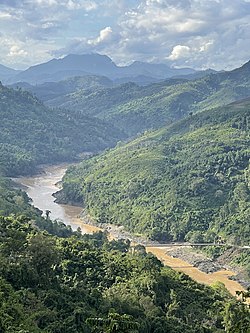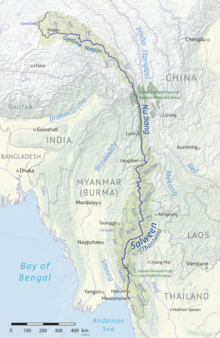
Back Salween Afrikaans نهر سالوين Arabic Ríu Salween AST Salvin çayı Azerbaijani سالوین چایی AZB Салуин Bashkir Tukad Salween BAN Салуін Byelorussian Салуин Bulgarian सालवीन नदी Bihari
| Salween Burmese: သံလွင်, Thanlwin (IPA: [θàɰ̃lwɪ̀ɰ̃ mjɪʔ] Chinese: 怒江; pinyin: Nù Jiāng Thai: แม่น้ำสาละวิน, Mae Nam Salawin (IPA: [mɛ̂ː náːm sǎːləwin] | |
|---|---|
 Salween River in Shan State, Myanmar | |
 Map of the Salween River basin | |
| Native name |
|
| Location | |
| Country | China, Myanmar (Burma), Thailand |
| Provinces (PRC) | Tibet Autonomous Region, Yunnan |
| States (Myanmar) | Shan, Karenni (Kayah), Karen (Kayin), Mon |
| Province (Thailand) | Mae Hong Son |
| Physical characteristics | |
| Source | Tanggula Mountains |
| • location | Nagqu, Tibet, China |
| • coordinates | 32°43′47″N 92°13′58″E / 32.72972°N 92.23278°E[1] |
| • elevation | 5,432 m (17,822 ft)[1] |
| Mouth | Andaman Sea |
• location | Mawlamyaing, Burma |
• coordinates | 16°11′39″N 97°35′00″E / 16.19417°N 97.58333°E |
• elevation | 0 m (0 ft) |
| Length | 3,289 km (2,044 mi)[2] |
| Basin size | 324,000 km2 (125,000 sq mi) |
| Discharge | |
| • location | Salween Delta, Andaman Sea |
| • average | 6,600 m3/s (230,000 cu ft/s)[4][5] to 211 km3/a (6,700 m3/s)[6] |
| • minimum | 2,300 m3/s (81,000 cu ft/s)[3] |
| • maximum | 32,600 m3/s (1,150,000 cu ft/s)[3] |
| Discharge | |
| • location | Mawlamyine, Myanmar |
| • average | 6,391.9 m3/s (225,730 cu ft/s)[7] |
| Discharge | |
| • location | Mottama, Myanmar |
| • average | 5,217.5 m3/s (184,250 cu ft/s)[7] |
| Discharge | |
| • location | Hpa-an, Myanmar |
| • average | 4,722.3 m3/s (166,770 cu ft/s)[9] (Period: 2009-2013)5,280 m3/s (186,000 cu ft/s)[8] |
| • minimum | 1,743 m3/s (61,600 cu ft/s)[8] |
| • maximum | 17,080 m3/s (603,000 cu ft/s)[8] |
| Discharge | |
| • location | Lushui, Nujiang Lisu Autonomous Prefecture, China |
| • average | 1,437 m3/s (50,700 cu ft/s)[10] |
| Basin features | |
| Tributaries | |
| • left | Suo River, Ga River, Hka River, Hsim River, Pai River, Moei River, Gyaing River |
| • right | Ba River, Leng River, Pang River, Teng River, Pawn River |
The Salween is a Southeast Asian river, about 3,289 kilometres (2,044 mi) long,[2] flowing from the Tibetan Plateau south into the Andaman Sea. The Salween flows primarily within southwest China and eastern Myanmar (Burma), with a short section forming the border of Burma and Thailand. Throughout most of its course, it runs swiftly through rugged mountain canyons. Despite the river's great length, only the last 90 km (56 mi) are navigable, where it forms a modest estuary and delta at Mawlamyine. The river is known by various names along its course, including the Thanlwin (named after Elaeocarpus sp., an olive-like plant that grows on its banks[11]) in Burma and the Nu Jiang (or Nu River, named after Nu people) in China. The commonly used spelling "Salween" is an anglicisation of the Burmese name dating from 19th-century British maps.
Due to its great range of elevation and latitude coupled with geographic isolation, the Salween basin is considered one of the most ecologically diverse regions in the world, containing an estimated 25 percent of the world's terrestrial animal species and thousands of plant species[citation needed]. Along its course the Salween provides water for agriculture and supports abundant fisheries, especially in the delta region. The Salween basin is home to numerous ethnic minority groups, whose ancestors largely originated in the Tibetan Plateau and northwest China. Starting about 5,000 years ago, people began migrating south along the river, establishing small kingdoms and city-states.
During the last 1,000 years, the Salween has defined various frontiers of the Burmese empires to the west, the Kingdom of Siam to the south, and Imperial China to the east, with the Shan States along the middle Salween being a frequently contested area. In the 19th century, the British Empire invaded Burma with Mawlamyine serving as the colonial capital for many decades. Since Burmese independence in 1948, the Salween basin has been a battleground for several fronts of the Burmese Civil War, with large areas in Shan State and Karen State (Kayin State) contested between the Burmese military and local ethnic militias.
The Salween is one of the least fragmented large river systems in Asia, with only a few small dams in the headwaters of the river and on tributaries. The river has extremely high hydropower potential, with a fall of more than 5,000 metres (16,000 ft) from its source. Since the 1970s, the Burmese and Thai governments have sought to build massive hydroelectric dams along the river. China also planned to dam the upper Salween, but in 2016 these plans were dropped in favor of establishing a national park. The future of dam projects in Myanmar and Thailand remains uncertain.
- ^ a b Cite error: The named reference
sciencenetwas invoked but never defined (see the help page). - ^ a b Lehner, B., Verdin, K., Jarvis, A. (2008): New global hydrography derived from spaceborne elevation data. Eos, Transactions, AGU, 89(10): 93–94.
- ^ a b "Myanmar: Third GMS Corridor Town Development Project" (PDF). 2017.
- ^ Cite error: The named reference
Baronaswas invoked but never defined (see the help page). - ^ "Bilin".
- ^ Harunur, Rashid; Alexandra, T. Gourlan; Brittany, Marche; Kaylyn, Sheppard; Nabil, Khélif (2019). "Changes in Indian Summer Monsoon Using Neodymium (Nd) Isotopes in the Andaman Sea During the Last 24,000 years" (PDF). Earth Systems and Environment. 3 (2): 105. Bibcode:2019ESE.....3..105R. doi:10.1007/s41748-019-00105-0. S2CID 198422435.
- ^ a b "Salween Delta".
- ^ a b c CHAPTER 5 NATURAL CONDITION SURVEYS (PDF).
- ^ "Lower Salween".
- ^ "Upper Salween".
- ^ Mason, Francis (1851). Tenasserim: Or Notes on the Fauna, Flora, Minerals, and Nations of British Burmah and Pegu. Maulmain: American Mission Press. p. 213.